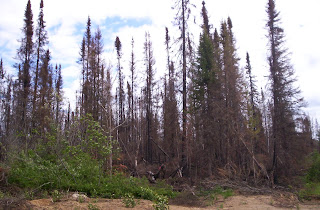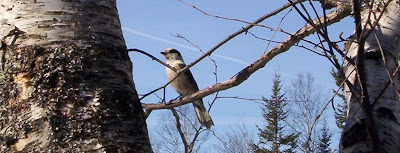A FORESTER'S REPORT OF 1972
 |
Cruisers of the '40's
White Lake, Ontario
photo courtesy of Nipigon Historical Museum Archives, L.M. Lein collection |
Note: November 11, 1983: This article was originally written in 1972 after the writer (L.M." Buzz" Lein) had been buffeted by some ecological groupies. It is more relevant today than it was when it was written.
(can we add ditto in 2011?)
I was an industrial forester.
I lived and worked in Northern Ontario where I was:
never seen,
never heard,
never believed
and
never listened to.
I was part forester,
part engineer,
part ecologist.
part labour relations expert,
part personnel expert,
part myth
and
almost a full time writer of science fiction.
This latter didn't command a great lot of attention because it dealt mostly with things like - how much will it cost to deliver a cord of wood to the mill in the 2500 A.D. The answer was simple - it won't cost anything because these won't be any wood to log.
It got a little tricky though, when dealing with the cost of capital equipment for the next 30 years. No one knew what kind of equipment they were talking about to handle all the non-existent wood.
It was also a tingly thrill to check on the survival rate of newly planted seedlings. Here one can let his imagination run riot. Computerized figures were real helpful - only the seedlings weren't aware of it all. No matter how I figured it out, only about 2% were shown as surviving.
And the hours and hours I spent on how much wood to cut?...It wouldn't have been so bad if there had been enough left to worry about.
I also helped in :
the cutting and harvesting of mature trees;
the building of miles and miles of roads so that people would have something to drive over during the fishing season;
I made impossibly elaborate forest fire fighting plans in case a fire broke out. This was mostly to impress some of my superiors who didn't know how to put a cat out at night let alone a forest fire. I always hoped that one would occur because if one did, there was only a few of us who actually knew what to do.
No, running away isn't the answer.
I also worried about the effects of having too much of our cutting area covered with over-mature or decadent forest that we couldn't afford to cut. There wasn't really that much wrong with them, but they didn't have the right label on them for a mill manager. What he wanted to see was a sign that proclaimed the tree to be a healthy spruce.
I worried about the fact that areas cut 20 years ago were not filled with young spruce 20 feet tall.
I was worried about all the things that were attacking the trees: worms - fires - insects - fungi - politicians - ridiculous extreme temperatures - mill demands ... where were all the trees we were going to need in the future?
And, above all, I wondered why the role of an industrial forester is so completely ignored, so completely misunderstood.
In places like Nipigon, where the town is surrounded by trees, it does not automatically follow that the townsfolk are aware of these trees or even aware of the tremendous financial contribution they make to the economy. Usually, the only time much attention is paid to the trees is in mid-December when everyone takes a six foot conifer out to lunch and then dumps it immediately after Xmas.
It is not possible to relate to what a dedicated industrial forester is doing without a little mental effort. A gas pump jockey may get aroused about the bad guys cutting all the trees and ruining the environment. A bank manager is never going to understand that trees have to be harvested when they are "ripe". He is also not going to get closer to Mother Nature than a Raid can can spray. However, mill manager, doctors, et al can't relate either.
An industrial forester doesn't do much to help break down the misunderstanding barrier. He really doesn't know how to do it. He has received little or no training in this regard. His forester superiors have the same handicap. They will not gracefully accept a junior forester on 50000 watts sounding off about the lack of growing atop the effects of poor wood utilization, poor planning or the bad effects of some organized group harassing him. In fire this junior forester will get yelled at - or fired - or both before everything calms down again.
Industrial foresters close to the tree cutting areas are a minority group. They are widely scattered; living comfortably in a small town out of the mainstream of public awareness. This is not difficult. The end result is public silence on the part of a group who are not about to become sacrificial bark beetles.
Almost everywhere there are evidences of:
Conservationists (real ones are rare)
Protectionists (woodsman, woodsman spare that tree)
Preservationists (wilderness areas are the most, man)
and
Consternationists ( What the hell are you guys trying to do, ruin this country?)
Note to the last guy: You are a little late my friend. Like about fifty years.
Fun, ain't it.
















































